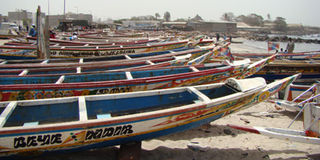Prime
Namibia’s fish not for the poor

Boats for the local fishing community. NET PHOTO
The South-western African republic is designed as a middle-income country, but the disparity between the rich and the poor, and a lingering economic apartheid, tell a different story
On a first time visit, Namibia is a land of plenty for everybody because the country’s vibrant mining and fishing sector have led to its classification as a middle-income country.
All these gains are in spite of the relatively young economy of the south-west African nation, which attained independence only 21 years ago.
Despite such seemingly good economic and social standing, a large portion of the population is poor and faces chronic economic insecurity. The huge socio-economic disparities are largely a reflection of colonialism and apartheid, but also of the class stratification that has taken place in post-independent Namibia.
The middle-income tag bestowed on Namibia places the country at shoulder level with some of the world’s fastest growing economies such as Brazil, China, Thailand, India and Indonesia. However, Namibia is, by far, poorer than these other countries, hence the government’s insistence that Namibia needs re-grading.
A high per capita GDP, relative to the region, hides the fact that most Namibians live in severe poverty due to large-scale unemployment. Testimony to this is the high levels of income disparities in the world, due to the legacy of apartheid.
To date, only a tiny proportion of the population enjoys a measure of wealth, as overall poverty rates are high, especially in rural areas. The rural poor are typically under-educated with limited access to health care, adequate sanitation and gas and electricity supplies.
Food shortages are a major problem during years of drought, and nutritional intake is consistently poor.
No agriculture
Namibia is unusual in the region in that rural people are less dependent on agriculture than their counterparts in other countries.
Sources such as pensions and remittances provide important additional income for many subsistence farmers.
The social and economic imbalances of the apartheid system, introduced into Namibia in 1964 under South African rule, left a deep divide in Namibian society.
These structural inequalities have made job creation and poverty reduction difficult. Redressing inequality of land distribution became a priority political issue for the government with the National Conference on Land Reform held in 1991. But since then land distribution has proved expensive and slow.
Poor farm lands
Commercial farmland for redistribution is located mainly in arid and semi-arid areas, and is suitable only for large-scale ranching.
In recent years the land question has become more complex and more pressing. Within communal areas, problems of conflict have arisen between poor farmers and better-off farmers who have fenced off land and access to water points.
The fishing industry has grown to the extent that it currently is Namibia’s second biggest export earner of foreign currency after mining (90 per cent of national output is marketed for export). It is also the third largest economic sector in terms of contribution to the Gross Domestic Product (GDP) which was about 10.1 per cent or N$1.477 billion for 1998.
Globally, Namibia ranks among the top ten fishing countries in terms of the value of production. In terms of its 400 kg per capita annual production, Namibia ranks second in the world. The industry employs about 14,000 workers, of whom about 43 per cent are sea-going personnel and 57 per cent are involved in onshore processing.
Despite all that, locals do not get to sample the fish. It is either too expensive or not readily available and seemingly destined for the foreign currency earner.
Mandatory permits
Locals are encouraged to seek fishing permits before catching even a single fish in the country’s waters. It involves red tape and delays, making it not worth of pursuing. Those who dare be brave and fish for the pot without permits are heavily fined, or even imprisoned, for their efforts.
All this despite the relatively easy procedure in attaining fishing permits for thousands of foreign anglers who descend on the Namibian coast for recreational fishing almost every day.
Government has over the years attempted to ensure value on fishing products is retained to benefit locals by encouraging the setting up of value-addition enterprises for the country’s vibrant fishing sector. This was intended to discourage the exporting of whole fish, while off-fish products could service an entire sub-industry on their own. Sadly, this is yet to take full shape.
Mining, in particular diamond mining, is by far the biggest earner of export income. Besides investment in the exploration for and exploitation of resources, investment opportunities also exist in mineral processing and manufacturing operations.
Namibia’s mining sector is the fifth largest in Africa. A number of minerals are extracted in the country, including arsenic trioxide, diamonds, cadmium, copper, gold, lead, silver, pyrite, zinc, tin, quartz, lithium, fluorspar, uranium, semi-precious stones, natural gas and industrial minerals.
Minerals for the rich
While mining might be a thriving industry, little or nothing trickles down to the local resident of the Erongo Region (host to some of the world’s largest uranium mines) or elsewhere in Namibia.
Foreign interests dominate the uranium mining sector, with Australia’s mining giant Rio Tinto holding the majority stake in Namibia’s Rossing Uranium, while Langer Heinrich and Areva Mines also have majority shares vested in countries outside Namibia, or Africa for that matter.
Recently, the local ministry of mines and energy was forced to intervene by declaring that rights to mine some of the country’s top minerals be vested only with a state owned company, in a bid to reserve some benefits from mining activities.
The ministry also extended the moratorium on the issuance of new uranium exploration licences. This was necessitated by the fact that locals that had such licences merely held onto them for the purpose of leasing or selling them to foreigners who would otherwise find it hard to secure such licenses. Foreigners are said to be offering less than market value for such licences.
Lest drastic changes take place, the majority of Namibians will continue living below the poverty line, while only a handful enjoy considerable wealth.
Experts argue that the localisation of the economy to limit certain business activities to locals, the relaxation of export tariffs for smaller business enterprises and the encouragement of manufacturing businesses, are some of the ways the country’s wheels of fortune could be turned in a boon for all concerned.


